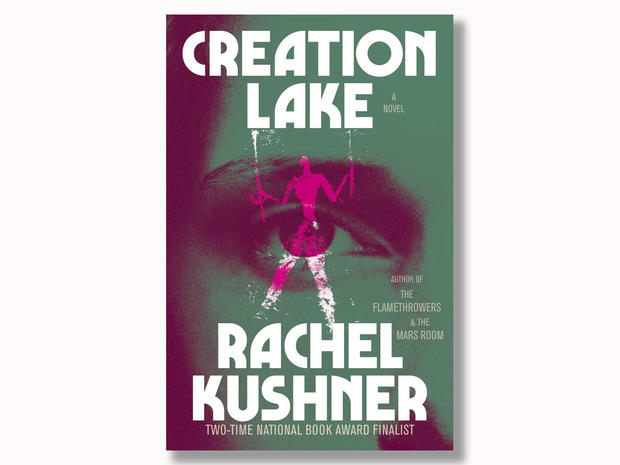We may receive an affiliate commission from anything you buy from this article.
In “Creation Lake” (Scribner), a tricky comic thriller from Rachel Kushner, a female American secret agent infiltrates a rural French commune of environmental terrorists who follow a mysterious spiritual leader whose teachings are aimed at replicating the lives of the Neanderthals.
Read an excerpt below.
“Creation Lake” by Rachel Kushner
Prefer to listen? Audible has a 30-day free trial available right now.
Neanderthals were prone to depression, he said.
He said they were prone to addiction, too, and especially smoking.
Although it was likely, he said, that these noble and mysterious Thals (as he sometimes referred to the Neanderthals) extracted nicotine from the tobacco plant by a cruder method, such as by chewing its leaves, before that critical point of inflection in the history of the world: when the first man touched the first tobacco leaf to the first fire.
Reading this part of Bruno’s email, scanning from “man” to “touch” to “leaf ” to “fire,” I pictured a 1950s greaser in a white T-shirt and a black leather jacket as he touches a lit match to the tip of his Camel cigarette, and inhales. The greaser leans against a wall—because that is what greasers do, they lean and loiter—and then he exhales.
Bruno Lacombe told Pascal, in these emails I was secretly reading, that the Neanderthals had very large brains. Or at least their skulls were very large, and we can safely infer that their skulls were likely filled, Bruno said, with brains.
He talked about the impressive size of a Thal’s braincase using modern metaphors, comparing them to motorcycle engines, which were also measured, he noted, for their displacement. Of all the humanlike species who stood up on two feet, who roamed the earth for the last one million years, Bruno said that the Neanderthal’s braincase was way out in front, at a whopping 1,800 cubic centimeters.
I pictured a king of the road, way out in front.
I saw his leather vest, his big gut, legs extended, engineers’ boots resting on roomy and chromed forward-mounted foot pegs. His chopper is fitted with ape hangers that he can barely reach, and which he pretends are not making his arms tired, are not causing terrible shooting pains to his lumbar region.
We know from their skulls, Bruno said, that Neanderthals had enormous faces.
I pictured Joan Crawford, that scale of face: dramatic, brutal, compelling.
And thereafter, in the natural history museum in my mind, the one I was creating as I read Bruno’s emails, its dioramas populated by figures in loincloths, with yellow teeth and matted hair, all these ancient people Bruno described—the men too—they all had Joan Crawford’s face.
They had her fair skin and her flaming red hair. A propensity for red hair, Bruno said, had been identified as a genetic trait of the Thal, as scientific advancements in gene mapping were made. And beyond such work, such proof, Bruno said, we might employ our natural intuition to suppose that like typical redheads, the Neanderthals’ emotions were strong and acute, spanning the heights and depths.
A few more things, Bruno wrote to Pascal, that we now know about Neanderthals: They were good at math. They did not enjoy crowds. They had strong stomachs and were not especially prone to ulcers, but their diet of constant barbecue did its damage as it would to anyone’s gut. They were extra vulnerable to tooth decay and gum disease. And they had overdeveloped jaws, wonderfully capable of chewing gristle and cartilage but inefficient for softer fare, a jaw that was overkill. Bruno described the jaw of the Neanderthal as a feature of pathos for its overdevelopment, the burden of a square jaw. He talked about sunk costs, as if the body were a capital investment, a fixed investment, the parts of the body like machines bolted to a factory floor, equipment that had been purchased and could not be resold. The Neanderthal jaw was a sunk cost.
Still, the Thal’s heavy bones and sturdy, heat-conserving build were to be admired, Bruno said. Especially compared to the breadstick limbs of modern man, Homo sapiens sapiens. (Bruno did not say “breadstick,” but since I was translating, as he was writing these emails in French, I drew from the full breadth of English, a wildly superior language and my native tongue.)
The Thals survived cold very well, he said, if not the eons, or so the story about them goes—a story that we must complicate, he said, if we are to know the truth about the ancient past, if we are to glimpse the truth about this world, now, and how to live in it, how to occupy the present, and where to go tomorrow.
My own tomorrow was thoroughly planned out. I would be meeting Pascal Balmy, leader of Le Moulin, to whom these emails from Bruno Lacombe were written. And I didn’t need the Neanderthals’ help on where to go: Pascal Balmy said to go to the Café de la Route on the main square in the little village of Vantôme at one p.m., and that was where I would be.
From “Creation Lake” by Rachel Kushner. Copyright © 2024 by Rachel Kushner. Excerpted with permission by Scribner, a division of Simon & Schuster, Inc.
Get the book here:
“Creation Lake” by Rachel Kushner
Buy locally from Bookshop.org
For more info:
Source : Cbs News













